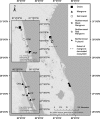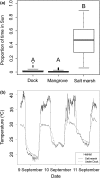An anthropogenic habitat within a suboptimal colonized ecosystem provides improved conditions for a range-shifting species
- PMID: 29435229
- PMCID: PMC5792588
- DOI: 10.1002/ece3.3739
An anthropogenic habitat within a suboptimal colonized ecosystem provides improved conditions for a range-shifting species
Abstract
Many species are shifting their ranges in response to the changing climate. In cases where such shifts lead to the colonization of a new ecosystem, it is critical to establish how the shifting species itself is impacted by novel environmental and biological interactions. Anthropogenic habitats that are analogous to the historic habitat of a shifting species may play a crucial role in the ability of that species to expand or persist in suboptimal colonized ecosystems. We tested if the anthropogenic habitat of docks, a likely mangrove analog, provides improved conditions for the range-shifting mangrove tree crab Aratus pisonii within the colonized suboptimal salt marsh ecosystem. To test if docks provided an improved habitat, we compared the impact of the salt marsh and dock habitats on ecological and life history traits that influence the ability of this species to persist and expand into the salt marsh and compared these back to baselines in the historic mangrove ecosystem. Specifically, we examined behavior, physiology, foraging, and the thermal conditions of A. pisonii in each habitat. We found that docks provide a more favorable thermal and foraging habitat than the surrounding salt marsh, while their ability to provide conditions which improved behavior and physiology was mixed. Our study shows that anthropogenic habitats can act as analogs to historic ecosystems and enhance the habitat quality for range-shifting species in colonized suboptimal ecosystems. If the patterns that we document are general across systems, then anthropogenic habitats may play an important facilitative role in the range shifts of species with continued climate change.
Keywords: Aratus pisonii; climate change; habitat analog; mangrove; salt marsh; thermal habitat.
Figures







References
-
- Beever III, J. W. , Simberloff, D. , & King, L. L. (1979). Herbivory and predation by the mangrove tree crab Aratus pisonii . Oecologia, 43, 317–328. https://doi.org/10.1007/BF00344958 - DOI - PubMed
-
- Belgrad, B. A. , Karan, J. , & Griffen, B. D. (2017). Individual personality associated with interactions between condition and the environment. Animal Behavior, 123, 277–284. https://doi.org/10.1016/j.anbehav.2016.11.008 - DOI
-
- Buck, T. L. , Breed, G. A. , Pennings, S. C. , Chase, M. E. , Zimmer, M. , & Carefoot, T. H. (2003). Diet choice in an omnivorous salt‐marsh crab: Different food types, body size, and habitat complexity. Journal of Experimental Marine Biology and Ecology, 292, 103–116. https://doi.org/10.1016/S0022-0981(03)00146-1 - DOI
-
- Canning‐Clode, J. , Fowler, A. E. , Byers, J. E. , Carlton, J. T. , & Ruiz, G. M. (2011). ‘Caribbean Creep’ chills out: Climate change and marine invasive species. PLoS ONE, 6, e29657 https://doi.org/10.1371/journal.pone.0029657 - DOI - PMC - PubMed
-
- Cannizzo, Z. J. , & Griffen, B. D. (2016). Changes in behaviour patterns by mangrove tree crabs following climate‐induced range shift into novel habitat. Animal Behavior, 121, 79–86. https://doi.org/10.1016/j.anbehav.2016.08.025 - DOI
LinkOut - more resources
Full Text Sources
Other Literature Sources

